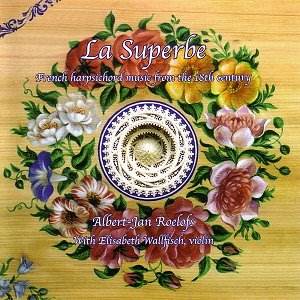A French harpsichord
‘school’ was late appearing on the scene.
This was mainly due to the dominant
position of the French lute composers
like Mouton, Dufaut and Gautier. The
first really important composer of harpsichord
music in France was Jacques Champion
de Chambonnières (1602-1672).
Louis-Nicolas Clérambault can
be considered a representative of the
'third generation' of harpsichord composers.
But his reputation was not based on
his harpsichord suites, of which he
composed only two. He was first and
foremost an organist, and in particular
admired for his chamber cantatas, which
show a strong Italian influence.
Clérambault's
suites reflect the end of the formal
development of the suite: the first
movement is a 'prélude non mesuré',
which is followed by the usual dances
in suites of the time: allemande, courante,
sarabande and gigue. There is also a
second sarabande, a gavotte and a pair
of menuets which conclude the suite.
In the liner notes Albert-Jan Roelofs
writes that the movements of this suite
are "rather conventional and academic
in their use of traditional dance forms
and harmonic progression". Is it this
judgement which makes his performance
less than inspired? At least the first
movements are not as free as one would
wish. The 'prélude non mesuré'
could have taken with a little more
freedom. In the sarabandes I would have
liked a stronger differentiation between
the notes. The gigue, though, is really
played well.
I was more impressed
by the next item on the programme: the
17th Ordre by Couperin. The music is
more imaginative than that of Clérambault,
and the interpretation reflects this.
Couperin's suites are unconventional,
in that he drops the title 'suite',
and only includes some of the then usual
dances. Instead we find here character
pieces, which would become very popular
during the 18th century. It is interesting
to hear or read what kind of interpretations
performers come up with in pieces like
these. In regard to 'Les Petits Moulins
à vent' (the little windmills),
for instance, Roelofs writes: "Usually
this title is interpreted as a reference
to the Parisian windmills. The lightness
of the piece and the small, repeated
musical motives makes one rather think
of the small paper windmills on top
of wooden sticks that bring great amusement
to children. One can easily imagine
the repeated blowing in order to keep
the small moulins moving. From
time to time they nearly stop, just
to be blown in action again." I find
this interpretation quite convincing
from a musical point of view. The question,
of course, then is: did those paper
windmills exist in Couperin's time?
The playing of this piece is excellent,
and makes the interpretation of the
title all the more convincing. In the
next piece in the Ordre, 'Timbres' (bells),
the technique of 'notes inégales'
is used quite brilliantly to illustrate
the irregular ringing of bells. The
Ordre starts with a musical portrait
of the famous French viol player and
composer Forqueray, called 'La Suberbe'
(which gave this disc its title): the
little breathing spaces create a strong
tension, which makes this piece very
enthralling.
The last composer on
the disc is Duphly, whose music shows
some features of the new developments
in the composing for the keyboard. It
is interesting that he also wrote a
piece in honour of Forqueray. I find
the performance a little hasty: slowing
down the tempo would have been appropriate
to give it more weight. The third book
also contains some pieces with an additional
part for the violin, which is either
playing colla parte with the upper part
of the keyboard or gets involved in
a dialogue with the harpsichord. I find
the playing of Elizabeth Wallfisch a
little too bland. Some ornamentation
- vibrato, for instance - would have
made the violin part more interesting.
There is nothing wrong with Roelofs'
playing, though.
The harpsichord is
a very beautiful instrument with a strong
sound and technically well recorded
here. The liner notes by Albert-Jan
Roelofs are informative and to the point.
As this recording is released by the
harpsichord maker one may assume it
is mainly aimed at presenting one of
his instruments to a wider audience.
That undertaking has succeeded, as far
as I am concerned. Since the performance
varies from good to excellent and the
disc contains a suite by Clérambault,
which is - as far as I know - not available
elsewhere, and the pieces with violin
by Duphly are also not frequently played
and recorded I don't hesitate to recommend
this disc.
Johan van Veen







